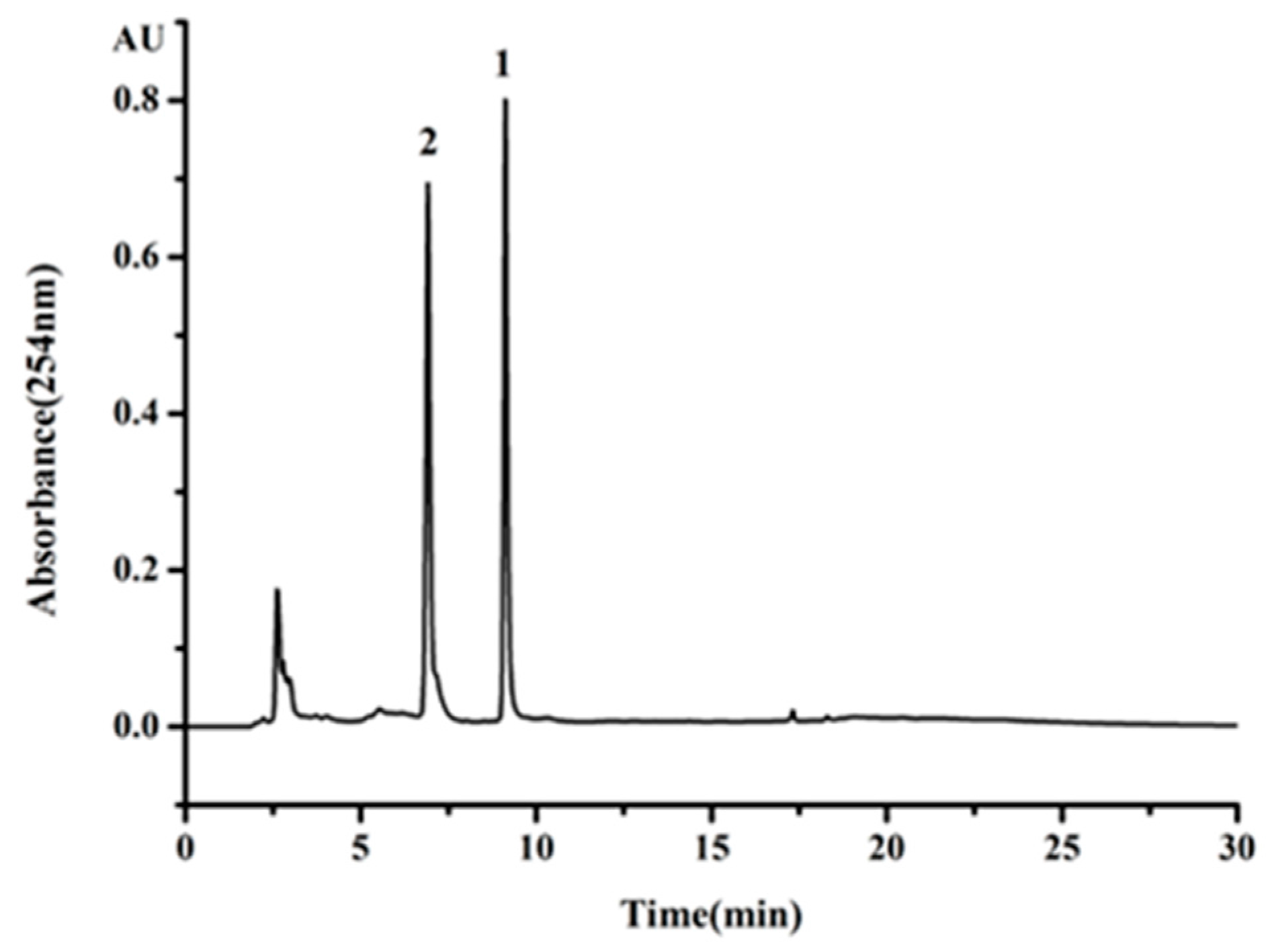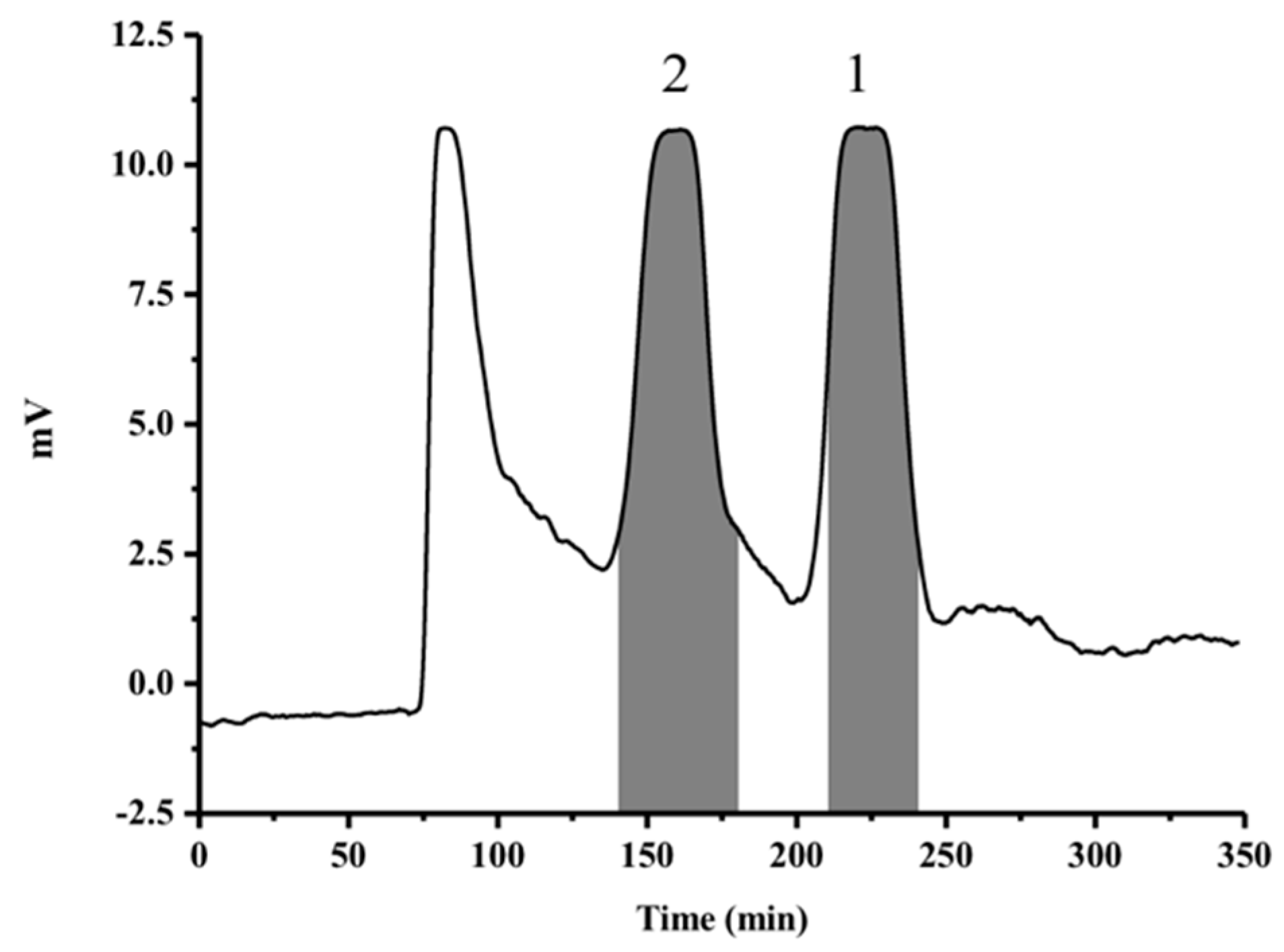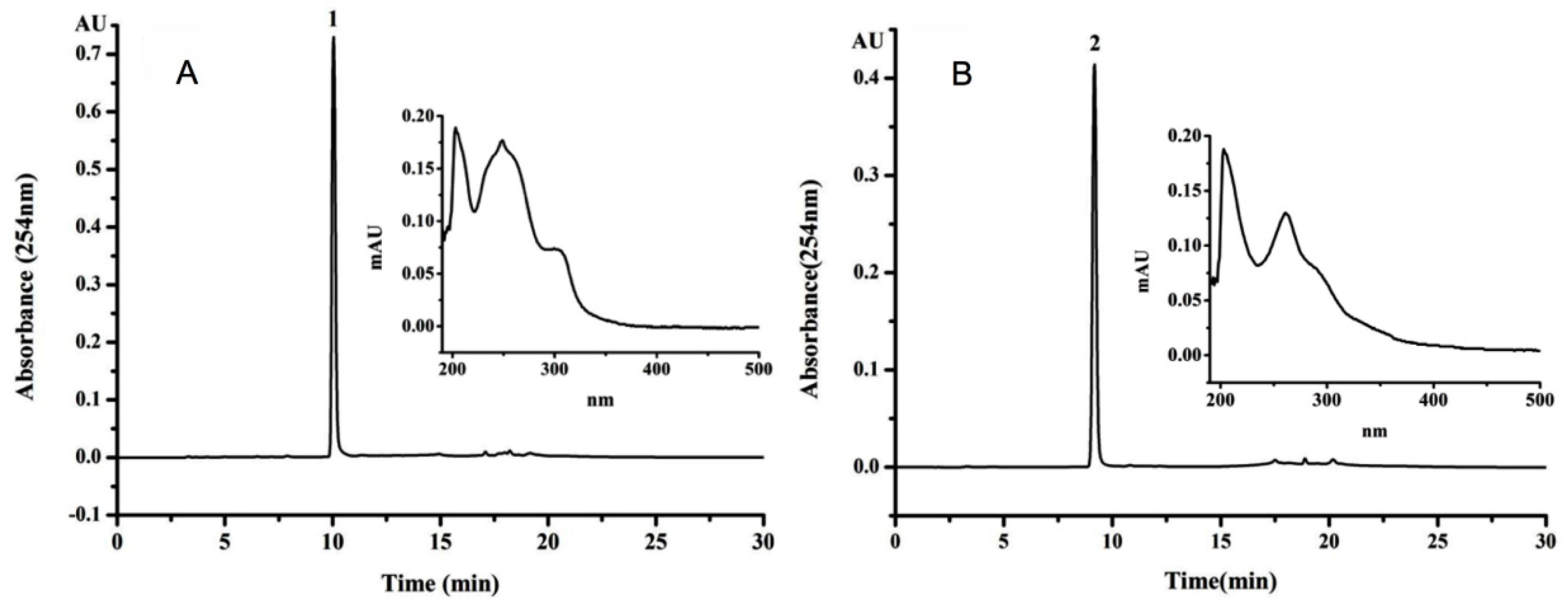Isolation and Purification of Two Isoflavones from Hericium erinaceum Mycelium by High-Speed Counter-Current Chromatography
Abstract
:1. Introduction
2. Results and Discussion
2.1. HPLC Analysis
2.2. Selection of Two-Phase Solvent System
2.3. HSCCC Separation
2.4. Identification of Chemical Structure
3. Experimental Section
3.1. HSCCC Apparatus
3.2. Reagents and Materials
3.3. Preparation of H. erinaceum Mycelium Extracts
3.4. Selection of Two-Phase Solvent
3.5. Preparation of the Two-Phase Solvent System and Sample Solution
3.6. HSCCC Separation
3.7. HPLC Analysis of HEM-E-E and Its HSCCC Fractions
3.8. Identification of HSCCC Peak Fractions
4. Conclusions
Acknowledgments
Author Contributions
Conflicts of Interest
References
- Chang, C.H.; Chen, Y.; Yew, X.X.; Chen, H.X.; Kim, J.X.; Chang, C.C.; Peng, C.C.; Peng, R.Y. Improvement of Erinacine A Productivity in Hericium erinaceus Mycelia and Its Neuroprotective Bioactivity against the Glutamate-Insulted Apoptosis. LWT Food Sci. Technol. 2016, 19, 616–626. [Google Scholar] [CrossRef]
- Jiang, S.; Wang, S.; Sun, Y.; Zhang, Q. Medicinal properties of Hericium erinaceus and its potential to formulate novel mushroom-based pharmaceuticals. Appl. Microbiol. Biotechnol. 2014, 98, 7661–7670. [Google Scholar] [CrossRef] [PubMed]
- Li, W.; Zhou, W.; Cha, J.Y.; Kwon, S.U.; Baek, K.H.; Shim, S.H.; Lee, Y.M.; Kim, Y.H. Sterols from Hericium erinaceum and their inhibition of TNF-α and NO production in lipopolysaccharide-induced RAW 264.7 cells. Phytochemistry 2015, 115, 231–238. [Google Scholar] [CrossRef] [PubMed]
- Mizuno, T. Yamabushitake, Hericium erinaceum: Bioactive substances and medicinal utilization. Food Rev. Int. 1995, 11, 173–178. [Google Scholar] [CrossRef]
- Okamoto, K.; Sakai, T.; Shimada, A.; Shirai, R.; Sakamoto, H.; Yoshida, S.; Ojima, F.; Ishiguro, Y.; Kawagishi, H. Antimicrobial chlorinated orcinol derivatives from mycelia of Hericium erinaceum. Phytochemistry 1993, 34, 1445–1446. [Google Scholar] [CrossRef]
- Mori, K.; Obara, Y.; Hirota, M.; Azumi, Y.; Kinugasa, S.; Inatomi, S.; Nakahata, N. Nerve growth factor-inducing activity of Hericium erinaceus in 1321N1 human astrocytoma cells. Biol. Pharm. Bull. 2008, 31, 1727. [Google Scholar] [CrossRef] [PubMed]
- Wong, K.H.; Vikineswary, S.; Abdullah, N.; Naidu, M.; Keynes, R. Activity of Aqueous Extracts of Lion’s Mane Mushroom Hericium erinaceus (Bull.: Fr.) Pers. (Aphyllophoromycetideae) on the Neural Cell Line NG108-15. Int. J. Med. Mushrooms 2007, 9, 57–65. [Google Scholar] [CrossRef]
- Chaiyasut, C.; Sivamaruthi, B.S. Anti-hyperglycemic property of Hericium erinaceus—A mini review. Asian Pac. J. Trop. Biomed. 2017, 7, 1036–1040. [Google Scholar] [CrossRef]
- Lu, C.C.; Huang, W.S.; Lee, K.F.; Lee, K.C.; Hsieh, M.C.; Huang, C.Y.; Lee, L.Y.; Lee, B.O.; Teng, C.C.; Shen, C.H. Inhibitory effect of Erinacines A on the growth of DLD-1 colorectal cancer cells is induced by generation of reactive oxygen species and activation of p70S6K and p21. J. Funct. Foods 2016, 21, 474–484. [Google Scholar] [CrossRef]
- Kawagishi, H.; Ando, M.; Shinba, K.; Sakamoto, H.; Yoshida, S.; Ojima, F.; Ishiguro, Y.; Ukai, N.; Furukawa, S. Chromans, hericenones F, G and H from the mushroom Hericium erinaceum. Phytochemistry 1992, 32, 175–178. [Google Scholar] [CrossRef]
- Kawagishi, H.; Shimada, A.; Hosokawa, S.; Mori, H.; Sakamoto, H.; Ishiguro, Y.; Sakemi, S.; Bordner, J.; Kojima, N.; Furukawa, S. Erinacines E, F, and G, stimulators of nerve growth factor (NGF)-synthesis, from the mycelia of Hericium erinaceum. Tetrahedron Lett. 1994, 35, 1569–1572. [Google Scholar] [CrossRef]
- Qin, L.; Chen, H. Enhancement of flavonoids extraction from fig leaf using steam explosion. Ind. Crops Prod. 2015, 69, 1–6. [Google Scholar] [CrossRef]
- Raffa, D.; Maggio, B.; Raimondi, M.V.; Plescia, F.; Daidone, G. Recent discoveries of anticancer flavonoids. Eur. J. Med. Chem. 2017, 142, 213–228. [Google Scholar] [CrossRef] [PubMed]
- Li, H.; Park, S.; Moon, B.; Yoo, Y.B.; Lee, Y.W.; Lee, C. Targeted phenolic analysis in Hericium erinaceum and its antioxidant activities. Food Sci. Biotechnol. 2012, 21, 881–888. [Google Scholar] [CrossRef]
- Xi, J.; Yan, L. Optimization of pressure-enhanced solid-liquid extraction of flavonoids from Flos Sophorae and evaluation of their antioxidant activity. Sep. Purif. Technol. 2017, 175, 170–176. [Google Scholar] [CrossRef]
- Huang, P.; Zhang, Q.; Pan, H.; Luan, L.; Liu, X.; Wu, Y. Optimization of integrated extraction-adsorption process for the extraction and purification of total flavonoids from Scutellariae barbatae herba. Sep. Purif. Technol. 2017, 175, 203–212. [Google Scholar] [CrossRef]
- Xiao, X.H.; Yuan, Z.Q.; Li, G.K. Preparation of phytosterols and phytol from edible marine algae by microwave-assisted extraction and high-speed counter-current chromatography. Sep. Purif. Technol. 2013, 104, 284–289. [Google Scholar] [CrossRef]
- Luo, L.; Yan, C.; Zhang, S.; Li, L.; Li, Y.; Zhou, P.; Sun, B. Preparative separation of grape skin polyphenols by high-speed counter-current chromatography. Food Chem. 2016, 212, 712–721. [Google Scholar] [CrossRef] [PubMed]
- Ma, C.; Wang, J.; Chu, H.; Zhang, X.; Wang, Z.; Wang, H.; Li, G. Purification and characterization of aporphine alkaloids from leaves of Nelumbo nucifera Gaertn and their effects on glucose consumption in 3T3-L1 adipocytes. Int. J. Mol. Sci. 2014, 15, 3481. [Google Scholar] [CrossRef] [PubMed]
- Ito, Y. Golden rules and pitfalls in selecting optimum conditions for high-speed counter-current chromatography. J. Chromatogr. A 2005, 1065, 145–168. [Google Scholar] [CrossRef] [PubMed]
- Chen, B.; Peng, Y.; Wang, X.; Li, Z.; Sun, Y. Preparative Separation and Purification of Four Glycosides from Gentianae radix by High-Speed Counter-Current Chromatography and Comparison of Their Anti-NO Production Effects. Molecules 2017, 22, 2. [Google Scholar] [CrossRef] [PubMed]
- Ma, C.; Hu, L.; Fu, Q.; Gu, X.; Tao, G.; Wang, H. Separation of four flavonoids from Rhodiola rosea by on-line combination of sample preparation and counter-current chromatography. J. Chromatogr. A 2013, 1306, 12–19. [Google Scholar] [CrossRef] [PubMed]
- Tang, Q.; Yang, C.; Ye, W.; Liu, J.; Zhao, S. Preparative isolation and purification of bioactive constituents from Aconitum coreanum by high-speed counter-current chromatography coupled with evaporative light scattering detection. J. Chromatogr. A 2007, 1144, 203–207. [Google Scholar] [CrossRef] [PubMed]
- Rts, F.; Welendorf, R.M.; Nigro, E.N.; Frighetto, N.; Siani, A.C. Isolation of ursolic acid from apple peels by high speed counter-current chromatography. Food Chem. 2008, 106, 767–771. [Google Scholar]
- Gutzeit, D.; Winterhalter, P.; Jerz, G. Application of preparative high-speed counter-current chromatography/electrospray ionization mass spectrometry for a fast screening and fractionation of polyphenols. J. Chromatogr. A 2007, 1172, 40–46. [Google Scholar] [CrossRef] [PubMed]
- Yao, S.; Liu, R.; Huang, X.; Kong, L. Preparative isolation and purification of chemical constituents from the root of Adenophora tetraphlla by high-speed counter-current chromatography with evaporative light scattering detection. J. Chromatogr. A 2007, 1139, 254–262. [Google Scholar] [CrossRef] [PubMed]
- Zhu, Y.; Liu, Y.; Zhan, Y.; Liu, L.; Xu, Y.; Xu, T.; Liu, T. Preparative isolation and purification of five flavonoid glycosides and one benzophenone galloyl glycoside from Psidium guajava by high-speed counter-current chromatography (HSCCC). Molecules 2013, 18, 15648–15661. [Google Scholar] [CrossRef] [PubMed]
- Zhang, S.; Li, L.; Cui, Y.; Luo, L.; Li, Y.; Zhou, P.; Sun, B. Preparative high-speed counter-current chromatography separation of grape seed proanthocyanidins according to degree of polymerization. Food Chem. 2017, 219, 399–407. [Google Scholar] [CrossRef] [PubMed]
- Friesen, J.B.; Pauli, G.F. G.U.E.S.S.—A generally useful estimate of solvent systems in CCC. J. Liq. Chromatogr. Relat. Technol. 2005, 28, 2777–2806. [Google Scholar] [CrossRef]
- Oka, F.; Oka, H.; Ito, Y. Systematic Search for Suitable 2-Phase Solvent Systems for High-Speed Countercurrent Chromatography. J. Chromatogr. A 1991, 538, 99–108. [Google Scholar] [CrossRef]
- Tian, G.L.; Zhang, U.; Zhang, T.Y.; Yang, F.Q.; Ito, Y. Separation of flavonoids from the seeds of Vernonia anthelmintica Willd by high-speed counter-current chromatography. J. Chromatogr. A 2004, 1049, 219–222. [Google Scholar] [CrossRef]
- Peng, J.; Jiang, Y.; Fan, G.; Chen, B.; Zhang, Q.; Chai, Y.; Wu, Y. Optimization suitable conditions for preparative isolation and separation of curculigoside and curculigoside B from Curculigo orchioides by high-speed counter-current chromatography. Sep. Purif. Technol. 2006, 52, 22–28. [Google Scholar] [CrossRef]
- Du, Q.; Wu, C.; Qian, G.; Wu, P.; Ito, Y. Relationship between the flow-rate of the mobile phase and retention of the stationary phase in counter-current chromatography. J. Chromatogr. A 1999, 835, 231–235. [Google Scholar] [CrossRef]
- Ma, X.F.; Tu, P.F.; Chen, Y.J.; Zhang, T.Y.; Wei, Y.; Ito, Y. Preparative isolation and purification of two isoflavones from Astragalus membranaceus Bge. var. mongholicus (Bge.) Hsiao by high-speed counter-current chromatography. J. Chromatogr. A 2003, 992, 193–197. [Google Scholar] [CrossRef]
- Liu, F.; Han, S.; Ni, Y.Y. Isolation and purification of four flavanones from peel of Citrus changshanensis. J. Food Process. Pres. 2017, 41. [Google Scholar] [CrossRef]
- Deng, S.; Deng, Z.; Fan, Y.; Peng, Y.; Li, J.; Xiong, D.; Liu, R. Isolation and purification of three flavonoid glycosides from the leaves of Nelumbo nucifera (Lotus) by high-speed counter-current chromatography. J. Chromatogr. B 2009, 877, 2487–2492. [Google Scholar] [CrossRef] [PubMed]
- Shinomiya, K.; Kabasawa, Y.; Nakazawa, H.; Ito, Y. Countercurrent chromatographic separation of soybean isoflavones by two different types of coil planet centrifuges with various two-phase solvent systems. J. Liq. Chromatogr. Relat. Technol. 2003, 26, 3497–3509. [Google Scholar] [CrossRef]
- Wang, Y.Q.; Tang, Y.; Liu, C.M.; Shi, C.; Zhang, Y.C. Determination and isolation of potential alpha-glucosidase and xanthine oxidase inhibitors from Trifolium pratense L. by ultrafiltration liquid chromatography and high-speed countercurrent chromatography. Med. Chem. Res. 2016, 25, 1020–1029. [Google Scholar] [CrossRef]
- Kinjo, J.E.; Furusawa, J.I.; Baba, J.; Takeshita, T.; Yamasaki, M.; Nohara, T. Studies on the Constituents of Pueraria-Lobata. 3. Isoflavonoids and Related-Compounds in the Roots and the Voluble Stems. Chem. Pharm. Bull. 1987, 35, 4846–4850. [Google Scholar] [CrossRef]
- Singh, H.; Singh, S.; Srivastava, A.; Tandon, P.; Bharti, P.; Kumar, S.; Dev, K.; Maurya, R. Study of hydrogen-bonding, vibrational dynamics and structure activity relationship of genistein using spectroscopic techniques coupled with DFT. J. Mol. Struct. 2017, 1130, 929–939. [Google Scholar] [CrossRef]
- Zhao, C.X.; Xu, Y.L.; He, C.H. Axial dispersion coefficient in high-speed counter-current chromatography. J. Chromatogr. A 2009, 1216, 4841–4846. [Google Scholar] [CrossRef] [PubMed]
Sample Availability: Samples of the H. erinaceus (Bull.: Fr.) Pers. mycelium powder, compounds 1 and 2 are available from the authors. |




| No | Solvent System | Ratio (v/v) | K Values a | α b | Settling Time | |
|---|---|---|---|---|---|---|
| Compound 1 | Compound 2 | |||||
| 1 | n-hexane-ethyl acetate-methanol-water | 1:1:1:1 | - | 0.24 | / | / |
| 2 | n-hexane-ethyl acetate-methanol-water | 3:2:3:2 | - | 0.27 | / | / |
| 3 | n-hexane-ethyl acetate-methanol-water | 4:5:4:5 | - | 0.25 | / | / |
| 4 | chloroform-methanol-water | 4:4.5:2.5 | 2.87 | 0.46 | 6.23 | / |
| 5 | chloroform-methanol-water | 5:4:2 | 4.36 | 1.26 | 3.46 | / |
| 6 | chloroform-methanol-water | 5:5:2 | 3.45 | 0.83 | 4.15 | / |
| 7 | chloroform-dichloromethane-methanol-water | 4:1.5:2:2 | 0.84 | 0.91 | 1.08 | 19 s |
| 8 | chloroform-dichloromethane-methanol-water | 4:2:3:2 | 0.87 | 0.56 | 1.55 | 14 s |
| 9 | chloroform-dichloromethane-methanol-water | 4:4.5:2:5 | 0.71 | 0.63 | 1.12 | 24 s |
| Flow-Rate (mL/min) | Separation-Time (min) | Retention (%) | Purity (%) | |
|---|---|---|---|---|
| Compound 1 | Compound 2 | |||
| 1 | 320 | 67.8 | 94.2 | 96.5 |
| 2 | 250 | 64.5 | 95.7 | 97.3 |
| 3 | 200 | 54.3 | 92.4 | 93.5 |
| Pos. | Genistein | Daidzein | ||
|---|---|---|---|---|
| δC | δH | δC | δH | |
| 2 | 154.77 | 8.30 (1H, s, H-2) | 154.68 | 8.13 (1H, s, H-2) |
| 3 | 124.71 | 125.95 | ||
| 4 | 182.23 | 178.18 | ||
| 5 | 163.84 | 128.52 | 8.06 (1H, d, J = 8.83Hz, H-5) | |
| 6 | 100.10 | 6.21 (1H, s, H-6) | 116.52 | 6.94 (1H, dd, J = 2.24, 8.83Hz, H-6) |
| 7 | 165.92 | 164.60 | ||
| 8 | 94.27 | 6.33 (1H, s, H-8) | 103.23 | 6.86 (1H, d, H-8) |
| 9 | 159.69 | 159.80 | ||
| 10 | 106.28 | 118.20 | ||
| 1′ | 123.29 | 124.29 | ||
| 2′ | 131.38 | 7.36 (1H, d, J = 8.48Hz, H-1′) | 131.42 | 7.37 (1H, d, H-1′) |
| 3′ | 116.25 | 6.84 (1H, d, J = 8.50Hz, H-2′) | 116.22 | 6.84 (1H, d, H-2′) |
| 4′ | 158.81 | 158.69 | ||
| 5′ | 116.25 | 6.84 (1H, d, J = 8.50Hz, H-3′) | 116.22 | 6.84 (1H, d, H-3′) |
| 6′ | 131.38 | 7.36 (1H, d, J = 8.48 Hz, H-4′) | 131.42 | 7.37 (1H, d, H-4′) |
© 2018 by the authors. Licensee MDPI, Basel, Switzerland. This article is an open access article distributed under the terms and conditions of the Creative Commons Attribution (CC BY) license (http://creativecommons.org/licenses/by/4.0/).
Share and Cite
He, J.; Fan, P.; Feng, S.; Shao, P.; Sun, P. Isolation and Purification of Two Isoflavones from Hericium erinaceum Mycelium by High-Speed Counter-Current Chromatography. Molecules 2018, 23, 560. https://doi.org/10.3390/molecules23030560
He J, Fan P, Feng S, Shao P, Sun P. Isolation and Purification of Two Isoflavones from Hericium erinaceum Mycelium by High-Speed Counter-Current Chromatography. Molecules. 2018; 23(3):560. https://doi.org/10.3390/molecules23030560
Chicago/Turabian StyleHe, Jinzhe, Peng Fan, Simin Feng, Ping Shao, and Peilong Sun. 2018. "Isolation and Purification of Two Isoflavones from Hericium erinaceum Mycelium by High-Speed Counter-Current Chromatography" Molecules 23, no. 3: 560. https://doi.org/10.3390/molecules23030560
APA StyleHe, J., Fan, P., Feng, S., Shao, P., & Sun, P. (2018). Isolation and Purification of Two Isoflavones from Hericium erinaceum Mycelium by High-Speed Counter-Current Chromatography. Molecules, 23(3), 560. https://doi.org/10.3390/molecules23030560





